Abschnitt 3.1 - 3 Workplaces and tasks: hazards and measures
3.1 General hazards in heat treatment plants and measures to be taken
3.1.1 Qualification of all parties involved
You are required by law to assign work only to employees who are actually capable of carrying out the work safely. You must therefore ensure that your employees are suitably qualified in consideration of the tasks requirements.
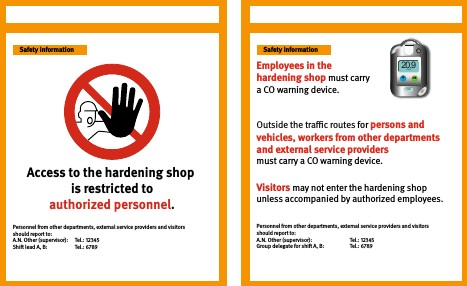
Figure 1
Example of access to the hardening shop with instructions for external parties
 | Statutory references |
|---|---|
| |
 | Further information |
|---|---|
| |
 | Hazards |
|---|
Heat treatment plants are not machines in the conventional sense (even where they fall within the scope of the Machinery Directive), but process engineering plants. This means that, in contrast to machinery, hazards are primarily caused not by mechanical movements or energy, but by physical phenomena such as temperature and pressure, and by the chemical properties of the substances used, such as (highly/easily) flammable, explosive or acutely toxic substances, or substances capable of causing skin damage.
A machine can usually be brought to a standstill very quickly, as can mechanical movements in process engineering plants. By contrast, a furnace retains its temperature even after the mechanical movements have stopped, and may still contain flammable toxic gases capable of forming a dangerous explosive atmosphere when mixed with air. Manual intervention may therefore be necessary to rectify the malfunction or shut down the system. Serious accidents continue to happen during such manual interventions.
Manual interventions in a process engineering system require comprehensive knowledge of the process concerned. Unfortunately, the formal training for universal hardeners that imparted this process engineering knowledge in the past no longer exists in Germany. The fundamentals of process engineering are addressed during the training of materials testers specializing in heat treatment technology, but the focus here is on materials science and testing.
The problem is exacerbated by modern control technology, which requires only minor intervention by the operating personnel under normal operating conditions. It is therefore difficult, if not impossible, for operators to become versed in all aspects of the process.
The important task of providing training in process engineering and in dealing with non-routine conditions, such as malfunctions, is an important function of your company.
 | Measures |
|---|
Workers are qualified to perform a task in the first instance by:
Briefing
Instruction
Past professional activity
Professional training
Seminars
Workers should be familiar with the hazards associated with their tasks, be capable of recognizing dangerous situations independently, and know what measures are to be taken. This applies in particular to malfunctions and unforeseen operating conditions.
In order to determine what qualifications are required for what tasks in heat treatment shops, we recommend creation of a qualification matrix. The qualification required for the individual tasks performed in heat treatment plants is to be determined in this matrix. The qualification matrix must be geared to the company’s organizational structure and the plants and processes used. Its scope must include parties who are not part of the heat treatment operation (e. g. external companies, temporary workers, visitors, etc.)
Technical Committee 8 of the Heat treatment and materials engineering working group (AWT), which deals with safety in heat treatment plants, has produced a document describing knowledge requirements for employees in hardening shops. The document provides examples of the range of tasks and the associated requirements profiles for workers in hardening shops.
After creating the qualification matrix, you can use it to decide what further training or other qualification measures for your employees are needed. For example, the German Social Accident Insurance Institutions offer a large number of seminars free of charge. You can also take advantage of the support provided by manufacturers or industry associations for further development of your employees’ qualifications.
 | Access to the heat treatment area |
|---|---|
The following measures have proved effective for access to heat treatment areas:
Further information can be found in DGUV Information 215-830 concerning the contracting of external companies for the provision of services. | |
3.1.2 Personal protective equipment
The aim of personal protective equipment is to reduce residual hazards that are not addressed by technical and organizational protective measures. Technical and organizational protective measures take priority over the use of personal protective equipment.
As an employer and/or manager, you have the duty to ensure that employees use the personal protective equipment specified in your risk assessment.
 | Statutory references |
|---|---|
| |
 | Further information |
|---|---|
| |
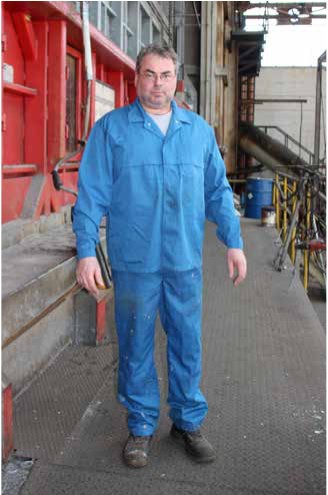
Figure 2
Flame-retardant work clothing
 | Hazards |
|---|
The use of personal protective equipment is intended to cover residual hazards that still exist once the possible technical and organizational measures have been exhausted. You determine the personal protective equipment required as part of the risk assessment for your company. The physical parameters and properties of the media used in heat treatment processes lead to specific requirements for personal protective equipment.
Selected examples:
High process temperatures or open flames
High thermal radiation
High penetration rate of methanol and therefore short service life of many glove materials
Caustic properties of ammonia or other substance
Toxicity of some hardening salts
Flaking off of scale or parts of workpieces
Unmarked hot parts in the vicinity
 | Measures |
|---|
In general, clothing made of natural fibres, particularly cotton, is recommended in areas in which heat treatment is performed. Clothing made of synthetic fibres melts at higher temperatures and is more flammable than cotton. Clothing made of natural fibres affords better protection against burn injuries.
You must provide your employees with the necessary personal protective equipment free of charge and, if necessary, offer or arrange for preventive occupational medical care.
Where the skin is exposed to hazards despite the use of personal protective equipment, further protective measures (such as establishing a skin protection plan) must be determined in consultation with the occupational physician.
In addition, when personal protective equipment is used, ensure that:
employees are instructed in the use of the personal protective equipment,
the personal protective equipment is stored properly at a designated location,
the personal protective equipment is checked before use and cleaned after use,
defective personal protective equipment is repaired or replaced before reuse.
Tips for the selection of personal protective equipment for the particular requirements of heat treatment plants:
Tasks performed on or in the vicinity of salt baths:
Polycarbonate face shields
Multi-layer protective clothing/clothing for protection against burns caused by liquid salt. The protective clothing should be made of strong cotton fabric, suitable for dry cleaning, with fireproof impregnation. Protective clothing made of synthetic fibres is unsuitable. Underwear should likewise not be made of synthetic fibres.
Multi-layer easily dropable mittens made of dense cotton fabric with gauntlet, the outer layer of which burns away and drops off upon contact with hot molten material
Ankle-high safety shoes (foundry boots)
Work clothing for tasks involving acutely toxic hazardous substances must be stored separately from private clothing.
Additional or other personal protective equipment, such as that for respiratory protection, may be required during maintenance and servicing tasks.
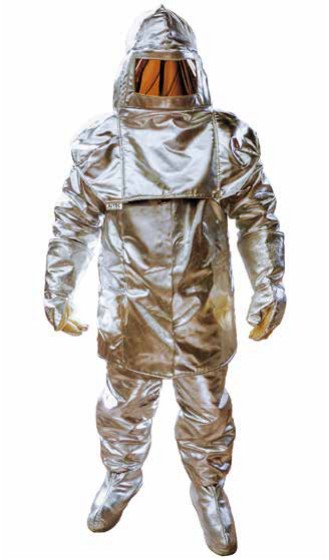
Figure 3
Aluminized thermal protection overall, shown here in combination with hand and head
protection
Protective clothing must be worn during tasks close to high heat or contact with flames. Such clothing is for example:
Flame-retardant protective clothing in accordance with EN ISO 14116. Ensure that the flame-retardant property of this clothing is not compromised by cleaning.
Heat-resistant protective clothing made of aluminium-laminated material offers even better protection, for example for work directly at the open furnace door. It is intended for protection of the face and body.
Heat-resistant safety shoes for work on furnace systems (in particular older systems with poor thermal insulation)
Safety glasses must be worn at workplaces involving very high infrared exposure (caused for example by light-red, yellow and white-hot material). Elevated exposure to infrared radiation over many years can cause cataracts (glassblower’s cataracts).
3.1.3 Work-related health hazards - mental stress
 | Statutory references |
|---|---|
| |
 | Further information |
|---|---|
| |
Activity-based, objective recording of relevant mental stress factors is part of the risk assessment.
Effects of the work content/work task, work organization, work environment and social relationships with a bearing upon mental health must be determined and analysed systematically during the risk assessment.
Numerous aspects of occupational activity may cause mental stress. In their joint declaration on mental health at work in 2013, the German Federal Ministry of Labour and Social Affairs * and the social partners published key characteristics of work-related mental stress and forms of it which may be critical.
 | Hazards (mental stress) |
|---|
Table 1
Classes of characteristics and content of the risk assessment for mental stress
| 1. | Class of characteristics: Work content/work task | Possible critical forms |
|---|---|---|
| 1.1. | Comprehensiveness of the task | The task includes:
|
| 1.2 | Freedom of action | The employee(s) has/have no influence upon the:
|
| 1.3 | Variety | One-sided requirements:
|
| 1.4 | Information/presentation of information |
|
| 1.5 | Responsibility |
|
| 1.6 | Qualifications |
|
| 1.7 | Emotional stress, caused by: |
|
| 2. | Class of characteristics: Work organization | Possible critical forms |
| 2.1 | Working hours |
|
| 2.2 | Working procedures |
|
| 2.3 | Communication/cooperation |
|
| 3. | Class of characteristics: Social relationships | Possible critical forms |
| 3.1 | Colleagues |
|
| 3.2 | Superiors |
|
| 4. | Class of characteristics: Work environment | Examples of negative effects |
| 4.1 | Physical and chemical factors |
|
| 4.2 | Human physical factors |
|
| 4.3 | Workplace and information design |
|
| 4.4 | Work equipment |
|
| 5. | Class of characteristics: New forms of work | Examples of negative effects |
| These characteristics are not the subject of supervisory activity, but are relevant to the employees’ stress situation. |
| |
Source: GDA brochure containing recommendations for implementing risk assessments of mental stress (2nd, extended edition, January 2016)
A wide range of instruments and methods for assessing the risk of mental stress exist which take account of different operational conditions and needs.
Mental stress can be determined during the risk assessment; analysis workshops, observational interviews and employee surveys are used for this purpose. Each of these procedures has its own advantages, but also specific requirements and limitations that need to be balanced against each other (refer to the overview of the procedures’ strengths and limitations provided in Annex 2 (recommendations and test questions for the selection of instruments/procedures) of the GDA brochure concerning recommendations for the implementation of risk assessments of mental stress (2nd, extended edition, January 2016)).
 | Measures |
|---|
The following general measures for work design have proved effective in protecting and enhancing health under circumstances of work-related mental stress:
Diversity in the requirements imposed by tasks and the information provided
Avoidance of fatigue by the use of buffers to decouple the cyclical completion of tasks, and the resulting increased autonomy
Job rotation, i.e. rotation of the work tasks and work locations
Job enlargement by quantitative expansion of tasks
Job enrichment by the combining of multiple work tasks to form one larger task
Where the task presents limited scope for structuring, extension of the options for action in working groups by the use of technical or organizational measures to transfer planning, decision-making and/or supervisory functions; where task requirements are tightly constrained, mechanization or automation of repetitive functions
Facilitation/support of opportunities for communication between employees
In the interests of good results, it is essential that employees be involved in the process of evaluating mental stress factors and, based upon the results, in defining protective measures.
3.1.4 Work-related health hazards - workplace health
 | Statutory references |
|---|---|
| |
 | Further information |
|---|---|
| |
 | Hazards |
|---|
Physical, chemical, biological, human physical and mental effects at work can impair or harm employees’ health (more information can be found in other chapters).
 | Measures |
|---|
Your employees often know best what affects them at their workplace or makes them ill. Actively involve your employees in a risk and stress assessment and include them when considering work design measures. This ensures greater acceptance and motivates your employees.
In individual cases, the statutory health insurance funds support their insured individuals and companies in organizing and delivering measures for the promotion of good health.
Preventing work-related health hazards by the use of appropriate measures for maintaining and enhancing the health of company employees has proved particularly effective in the following areas (see also DGUV Workplace health Expert committee):
Work in the context of demographic change
Work organization/health-conscious design of work tasks
Corporate integration management
Promotion of exercise
Promotion of healthy nutrition
Health-enhancing leadership behaviour
Prevention of violence
Inter-cultural aspects of prevention
Mental stress and strain
Addiction prevention
3.1.5 Competence, qualification, preventive medical care, aptitude
Where particularly dangerous tasks are performed, employers must observe specific rights and duties in order to avoid endangering the safety and health of workers at work. These rights and duties may be set out in acts, subordinate legislation and other regulatory instruments, and in employment contracts, collective agreements or company agreements.
This includes the observance of arrangements and/or agreements concerning competence, qualification, preventive medical care and aptitude which may be based upon a range of statutory instruments, and the observance or non-observance may have a range of legal consequences. In addition, responsibilities arising from management tasks, for example where duties are transferred or delegated and management tasks are performed locally, have a high priority in this context. The active cooperation of employees in this context is also mandatory.
Parties involved at the company level assume their respective responsibilities for the safety and health of employees at work in the four areas of competence, qualification, preventive medical care and aptitude.
A physician specialized in occupational medicine has a special function, as he or she may be in direct contact with the individual employees in the four areas, according to the underlying situation in the company. In order to be able to carry out these tasks, the occupational physician must have personal knowledge of the workplace conditions.
| Section 6, ArbMedVV (1) [...] Before performing preventive occupational medical care, he or she must acquire the necessary knowledge of the workplace conditions. |
|---|
 | Statutory references |
|---|---|
| |
 | Further information |
|---|---|
| |
Competence, qualification
Superiors must review an employee's competence for a specific task. In addition to the formal qualifications (training, driving licence, instruction), superiors must also form their own opinion of the employees’ physical condition. They usually do so at the start of the work/shift.
| Section 7 (1) of DGUV Regulation 1: "When assigning tasks to insured persons, the
employer shall consider whether the insured persons are able to comply with the safety
and health rules and measures applicable to their specific tasks. The employer shall
also take into consideration the required qualifications for specific tasks." Section 7 (2) of DGUV Regulation 1: "The employer must not assign to insured persons tasks that they are clearly unable to perform without causing risk to themselves or others." |
|---|
Details of the definition of competence and qualification, their determination, when they are determined and the particular requirements relating to them are set out in DGUV Rule 100-001 concerning principles of prevention.
Superiors can also check the competence of their employees during the regular provision of occupational safety instruction. If necessary, practical exercises can assist here in identifying the level of qualification or any technical or physical deficits which may be present. Drills in the use of personal protective equipment against falls from a height can for example reveal deficits in mental aptitude (fear of heights) and physical fitness.
Preventive occupational medical care
Preventive occupational medical care is among the measures for assuring the safety and health of workers at work and is governed comprehensively in the German Ordinance on preventive occupational medical care (ArbMedVV). Its principal content is summarized below. Preventive occupational medical care must not be a substitute for technical and organizational occupational safety and health measures. In the form of personal occupational medical advice on work-related health hazards, it is however a valuable complement to these measures.
The purpose of preventive occupational medical care is to assess the mutual influences of an individual’s work and their physical and mental health. It involves a medical consultation with case history, including work history. This preventive medical care is intended to detect work-related health disorders at an early stage and to determine whether performance of a particular activity is associated with an elevated risk to health.
Before conducting a preventive medical consultation, the occupational medical specialist must familiarize him or herself with the conditions at the workplace.
Mandatory and optional preventive medical consultations must be instigated or offered by employers according to whether tasks involve the hazardous substances, biological agents, physical effects and other tasks listed in the annex of the ArbMedVV. Optional preventive occupational medical consultations must be offered to employees who perform tasks in which harm to their health cannot be ruled out.
As part of the preventive occupational medical consultations, physical and/or clinical examinations are conducted as required when:
They are required for the advising of individuals
The physician has informed the subject of the preventive occupational medical care of content of the measure, its purpose and the associated risks
The subject of the preventive occupational medical care does not refuse to be examined
The certificate of preventive occupational medical care states that a preventive occupational medical consultation was conducted, when and for what reason and also when, in the physician’s opinion, the next consultation is required. Identical certificates of the measure are issued to the employer and the person undergoing the consultation.
The physician must record the results and findings of the consultation in writing, provide advice to the individual concerned with reference to the results and findings, and make the results available to the individual at his or her request, if applicable also in writing. The physician is obliged to respect medical confidentiality with respect to third parties, i.e. including to the employer.
Should however the occupational medical consultation reveal that the existing occupational health measures for the employees are inadequate, physicians must inform employers of the fact and propose suitable measures. The employer must then review the risk assessment and take the necessary measures for occupational safety and health.
The annex to the ArbMedVV contains an exhaustive list of tasks for which a mandatory preventive occupational medical consultation must be arranged or an optional consultation offered.
Aptitude examinations
Aptitude (fitness) examinations serve to determine whether, in consideration of the employees’ existing and potential physical and mental abilities, they may be considered capable of performing the tasks expected of them in their employment
The key instrument for the avoidance of hazards to safety and health at work is always the risk assessment in the company concerned.
Routine aptitude examinations
Where particularly hazardous tasks are performed, the risk assessment may reveal a possible need for additional routine aptitude examinations. This is the case when the following criteria apply:
Performance of the task is associated with a hazard to third parties that cannot be ruled out and
the examination is mandatory owing to specific statutory requirements or requirements deriving from labour law (employment contract, works agreement, collective agreement) and
the employee has consented to the specific examination.
Aptitude examinations are permissible only where the employer has a legitimate interest in determining the employee’s aptitude. This applies in particular to examinations performed in the absence of an evident risk situation. All examinations must respect the principle of proportionality (appropriate, necessary, reasonable).
The examination must first determine the employee’s aptitude in the first instance for the specific activity. Should an examination or examination method not enable aptitude to be established, it is not proportionate.
The examination is required when, of the conceivable alternatives available, it constitutes the most benign means of determining aptitude. Should it be possible for aptitude to be established by another, equally effective measure, the examination is not proportionate and therefore inadmissible.
The examination is reasonable when, should the employee not or no longer exhibit aptitude, performance of the task would endanger the life and limb of other persons and the aptitude examination would by comparison present only a minor burden for the employee.
Aptitude examinations conducted owing to clear signs of deficiencies in aptitude
Outside the scope of the routine aptitude examinations, the employer may make continued performance of the task concerned dependent on a medical certificate of aptitude in cases where specific and reasonable doubt exists that employees still exhibit aptitude for continued performance of the task in question (employer's duty of care).
Reasonable doubt may exist when sufficient factual evidence indicates a lack of aptitude. In such scenarios, employees' duty to cooperate may in exceptional cases also derive from the secondary obligation imposed by their employment contracts to take account of the employer's interests (contractual duty of loyalty) in accordance with Section 241 (2) of the German Civil Code (BGB).
Under these circumstances, too, the aptitude examinations must meet the criterion of proportionality.
Requirements to be met by physicians conducting aptitude examinations
Employers may in the first instance appoint a physician of their choice to carry out aptitude examinations. Should the employee assert reasoned concerns, for example with regard to the physician's expertise or impartiality, employers may have an equitable obligation (Section 315 (1) of the BGB) to task a different physician with conducting the examination. This equitable obligation entails balancing the interests of the two parties objectively.
Since knowledge of the job concerned is absolutely essential for assessing aptitude, the physician will normally be a specialist in occupational medicine.
The physician must be personally familiar with the requirements presented by the job concerned. An important aspect of this is the risk assessment of the work areas concerned. The risk assessment is produced by the employer following consultation with the occupational physician and OSH professional.
Result of the aptitude examination
The aptitude examination may reveal that the employee no longer possesses the aptitude to perform individual tasks within his or her area of work. This situation may be temporary or permanent or may lend itself to correction by means of certain work design measures. The primary objective must be for the employee to continue working in the company, with consideration for his or her personal impairments. Should the aptitude examination suggest that the existing occupational safety and health measures are not sufficient, the physician must inform the employer and propose suitable measures.
3.1.6 Fire safety
The process media used in heat treatment plants lead to an elevated fire risk. In order to prevent this hazard from materializing in your plant, implement fire safety measures thoroughly and give consideration to the particular underlying conditions in heat treatment plants.
 | Statutory references |
|---|---|
| |
 | Further information |
|---|---|
| |
 | Hazards |
|---|
Should a fire break out, harm to persons is to be expected in addition to damage to property. The harm to persons is caused mainly by the following hazards:
Inhalation of smoke
Burns on hot parts and media
Burns caused by flames
 | Measures |
|---|
You must draw up an escape and rescue plan for areas where required by their location, size or form of use (e.g. rooms in which a risk of fire and toxic substances exists).
In order to prevent fires or to minimize their effects, take the following measures in your company:
Keep the fire load in the proximity of heat treatment plant as low as possible. Essential measures for this purpose include:
Removing packing material
Regularly emptying oil collecting trays
Regularly removing oil deposits on plant and equipment
Removing oil binding agents immediately once they have been used to collect oil spills
Not storing collected materials contaminated by oil, such as cleaning rags or other waste soiled by oil, in the proximity of furnaces. If this cannot be avoided for operational reasons, use self-closing metal containers.
When soiled with nitrite/nitrate salts, organic materials such as wood or rags constitute a fire hazard that is difficult to extinguish. For this reason, remove these materials from the proximity of salt baths.
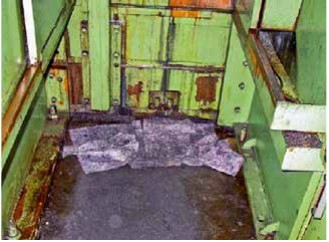
Figure 4
Increased fire load due to cleaning cloths soaked in oil
Keep an adequate number of fire extinguishing appliances (such as fire extinguishers) suitable for the fire classes present on the site at easily accessible points. Take the potential fire load into account. Water for example is not a suitable extinguishing agent for oil bath fires or fires in the proximity of salt baths. For cyanide or nitrite/nitrate salt baths, fire extinguishers with a basified extinguishing powder must be provided. Should acidic extinguishing agents be used, salts containing cyanide may lead to the formation of hydrocyanic acid, nitrite/nitrate salts may lead to the formation of nitrous gases.
Equip areas presenting an elevated fire risk with automatic fire alarm systems to enable fires to be detected as soon as they arise.
Observe the building regulations of the German regional authorities and the local industrial building codes during all structural fire safety measures.
Should the hazard to the user prevent fire extinguishing apparatus from being used to fight a fire or where hazardous areas are not accessible, the installation of stationary fire extinguishing systems may be advisable (such as sprinkler systems or water spray, water mist, foam, powder or gas extinguishing systems).
Where CO2 is used as the extinguishing agent, consideration must be given to the oxygen displacement and the associated danger of suffocation. CO2 fire extinguishers are unsuitable for small rooms for this reason. An evacuation concept may therefore be required where CO2 fire extinguishing systems are used.
Instructing as many plant employees as possible in the use of the fire extinguishing apparatus has proved invaluable. Arrange for regular drills in use of the apparatus. The more proficient your employees are in handling the apparatus, the more reliably fires are extinguished as they arise and before any major damage or harm occurs. At least 5 % of the workforce should be trained as fire protection assistants, and preferably workers in areas presenting an elevated fire risk.
Appoint a fire safety officer who will advise and support you on plant fire safety issues.
Draw up an emergency plan covering fires, accidents and incidents requiring evacuation. The following points should be considered in the emergency plan:
Reporting chain for emergencies
Rescue of injured persons
Evacuation concept for the buildings
Emergency shut-down concept for media and energy
An evacuation concept must cover not only rapid evacuation of affected areas, but also the reporting of which areas have been reliably evacuated, in which areas persons are still present, and whether persons are missing. The concept must take account not only of the company’s own employees, but also of external parties such as employees of external companies (for example cleaning staff ), customers and visitors; see also → 3.1.1 Access to the heat treatment area.
Practical experience has shown that a building cannot be evacuated effectively and quickly unless training has been provided in the form of evacuation drills. For this reason, conduct regular evacuation drills with your employees.
Since oil fires produce thick smoke which rapidly makes orientation in the affected rooms difficult, escape routes must be marked and kept clear. Escape routes can be signed for example by photoluminescent markings on the floor.
To facilitate fire control and reduce the effects of a fire to a minimum, the supply of energy and media (particularly flammable gases) to a plant or operating unit should be shut off. Check whether the supply of energy and media can be shut off from outside the potential danger zone. If necessary, change the arrangements. Provide instruction and training in implementing the shut-off concept. As with other safety devices, regularly check the function of isolating/shut-off devices.
Unfortunately, it is not uncommon for the fire service to fail to take the appropriate measures immediately upon its arrival. This is due to the fire service being unfamiliar with the particular features of the heat treatment plant and to impaired communication during an emergency. Maintaining regular contact with the responsible fire service through fire safety inspections and joint exercises is therefore strongly recommended.
For this reason, provide the fire service with a fire service plan (in digital and paper form) in accordance with DIN 14095:2007-05. This plan can form the basis for coordination with the fire service. Its content includes information on:
Entrances for persons and vehicles
Floor plans of all buildings/plants
Fire safety equipment
The fire load present (e.g. hardening oil)
Unsuitable extinguishing agents (e.g. water in the proximity of salt baths)
Other media (e.g. ammonia, propane, methanol, etc.) and the storage of media
Other hazardous substances used (e.g. hardening salts)
Further hazardous zones (such as electrical control rooms)
Individuals responsible, contact details
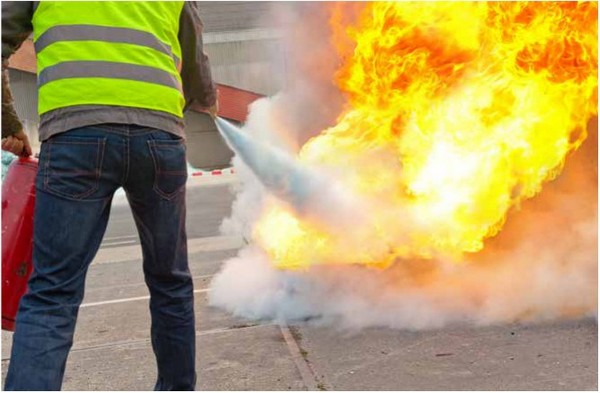
Figure 5
Use of a portable fire extinguisher
Suitable fire extinguishing procedures should also be agreed with the fire service and specified in the fire service plan. Gas fires for example should not be extinguished by means of extinguishing agents, but by shutting off the gas supply line. It may be necessary for larger quantities of special extinguishing agents to be kept available for use by the fire service.
In addition to these more general aspects of fire safety measures, consider the following particular aspects of heat treatment shops:
Hydraulic systems, especially hydraulic hoses, constitute a particular source of danger in heat treatment plants. Should a leak from a hydraulic system occur, the high pressures cause the escaping hydraulic oil to be sprayed in the form of fine mist. Should this mist come into contact with a source of ignition (e.g. a hot surface or pilot flame), it ignites immediately. This poses a huge risk to persons in the vicinity. Where a hydraulic system cannot be installed such that it is protected from potential ignition sources, the installation of screen plates is therefore recommended.
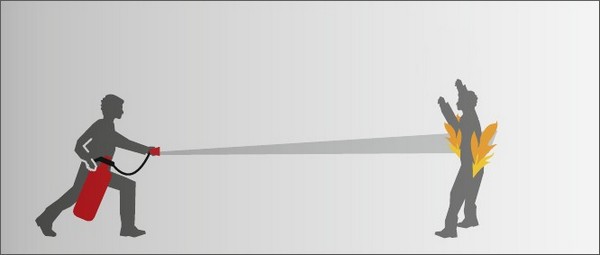
Figure 6
Extinguishing a fire on a person
 | Fires on persons |
|---|---|
| Suitable measures for fighting fires on persons must be selected with reference to
the risk assessment for the workplace or activity concerned. Fire blankets are no longer considered a good means of extinguishing fires on persons. Where present, emergency safety showers can be used immediately to good effect; fire extinguishers should be used in all other cases. Fire extinguishers enable fires to be fought safely and quickly without presenting an additional risk of injury. A fire extinguisher can be used extremely effectively to put out a fire on a person - irrespective of the type of extinguisher. Even a carbon dioxide (CO2) extinguisher is suitable, but should be used only if no other extinguisher is available. Contact between CO2(approx. -70°C) and the skin presents a risk of frostbite. Observe the following instructions for the correct use of the fire extinguisher, in order to prevent the person on fire from being exposed to additional risk.
If a CO2fire extinguisher is used, observe the following additional points:
| |
3.1.7 Temporary storage and manual transport of hardening material
Heat treatment plants usually have a high throughput of workpieces. The workpieces must be delivered and received, temporarily stored, managed, loaded if necessary onto fixtures, and finally packed again for dispatch.
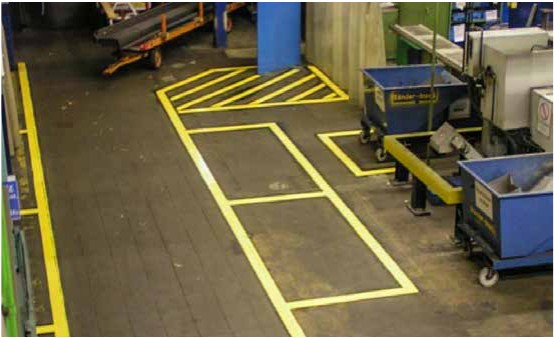
Figure 7
Marking of traffic routes, reception/staging areas and closed areas
 | Statutory references |
|---|---|
| |
 | Hazards |
|---|
A variety of hazards arise during storage (including interim storage, staging at the heat treatment plant) and the manual transport of workpieces. These particularly include:
Injuries caused by workpieces falling or tipping due to unsuitable means of storage or during interim storage or staging
Injuries caused by workpieces tipping or falling out of damaged fixtures
Injuries caused by damaged fixtures
Injuries occurring during manual handling of workpieces owing to sharp or pointed geometry of the workpieces or fixtures
Excessive load upon the musculoskeletal system during the manual transport of workpieces due to their weight and frequency of transport
Injuries caused by material falling during transport by manual pallet truck, and by collisions with persons
 | Measures |
|---|
Take the following measures in order to reduce or prevent hazards during storage and manual transport:
Storage areas
Mark the designated storage areas in order to prevent traffic routes from being obstructed.
Traffic routes must have the specified dimensions and must not be obstructed or restricted. This particularly applies to escape and rescue routes.
Storage equipment (shelves etc.)
Storage equipment must be suitable for the goods stored in it. Pay particular attention to:
The intended use and the manufacturer’s further information on use
Stability, and whether vertical or horizontal storage is intended
The permissible maximum individual and total load for shelves
Marking of permissible loads
Securing of stored items to prevent them falling out of or off the shelves
Protection against collision during loading by means of forklift trucks
Arrange for the storage equipment to be checked regularly. Have any damage impacting safety repaired immediately by a professional.
Pallets and containers
Pallets and containers must be suitable for the goods stored on/in them and be in good condition. Pay particular attention to the following:
Observe the permissible payloads, superimposed loads and stacking heights.
Stacks must be vertical with a maximum permissible deviation from the vertical of 2 %.
Where containers are stacked, the imposed load must decrease towards the top.
Ladders or other objects must not be leaned against stacks.
Repair damaged pallets or containers or take them out of use.
Have pallets or containers checked prior to reuse.
Protruding or overhanging material presents a risk of injury. If this cannot be avoided, the point concerned must be safeguarded, or at the very least clearly marked.
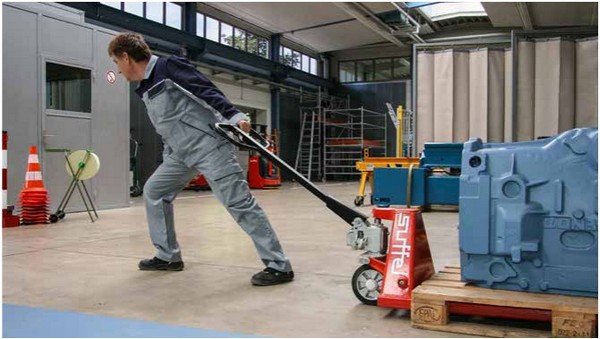
Figure 8
Hand-guided industrial truck
Manual transport
During manual transport/picking of workpieces, mechanical injuries are caused particularly often by the workpiece geometry (sharp-edged or pointed) and strains on the musculoskeletal system due to the weight.
To prevent the workpiece geometry and weight from being a hazard, pay attention to the following:
Wearing protective gloves with adequate cut protection is advisable when workpieces of sharp or pointed geometry are handled.
The key indicator method of the BAuA (German Federal Institute for Occupational Safety and Health) for the assessment of lifting, holding and carrying provides useful guidelines for avoiding excess strain upon the musculoskeletal system.
 https://www.baua.de Search: LMM
https://www.baua.de Search: LMM
Transport by manual pallet truck or pedestrian-operated industrial truck
Special training as required for operating a forklift truck with driver’s seat is not required for operation of this equipment. Thorough briefing and instruction is however required. Note the following in particular:
When operating pallet trucks, ensure that the load is placed as low as possible, with approx. 5 to 10 cm between the lower edge of the load and the floor.
Stacked loads tip easily.
On gradients (such as ramps), the weight must be braked by hand.
The key indicator method of the BAuA (German Federal Institute for Occupational Safety and Health) for the assessment of pushing and pulling provides useful guidelines for avoiding excess strain upon the musculoskeletal system.
 https://www.baua.de Search: LMM
https://www.baua.de Search: LMM
 | Width of circulation routes |
|---|---|
| The width of the traffic routes is dictated primarily by the width of vehicles and the average number of persons using the routes (see Table 2 on the following page). | |
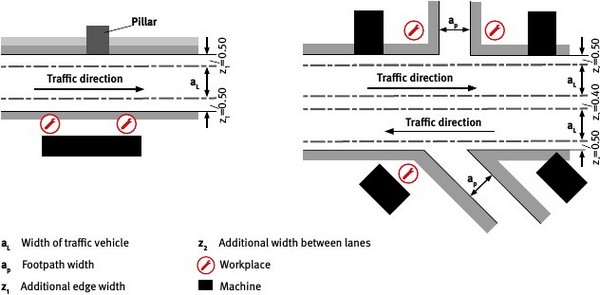
Figure 9
Width of even traffic routes
Table 2
Width of traffic routes
| Type of traffic route | Conditions | Minimum width in m | Remarks |
|---|---|---|---|
| Footpath | Main route | 1.25 | Dependent upon the number of users |
| Footpath | Secondary route | 0.75 | |
| Roadway for vehicles | One-way: speed < 20 km/h | Vehicle or load width + 1.0 m | The greater of the two widths is decisive; at higher speeds the additional component must be increased. |
| Roadway for vehicles | Two-way: speed < 20 km/h | Double the vehicle/load width + 1.4 m | The greater of the two widths is decisive; at higher speeds the additional component must be increased. |
| Combined footpath and roadway | Not permissible close to gates. | Width as for the corresponding roadway + 0.5 m | Safeguard crossings and stairway exits particularly well. |
3.1.8 Industrial trucks
Large material flows are a characteristic feature of heat treatment shops. Forklift trucks are most commonly used for this purpose. Heavy hardening material, large material volumes and space constraints that are often tight contribute to the hazard arising during material handling.
 | Statutory references |
|---|---|
| |
 | Further information |
|---|---|
| |
 | Hazards |
|---|
The following hazards occur during transport with forklift trucks:
Overloading of the forklift truck
Crushing and shearing points on the mast
Collision with persons or objects
Loads falling onto the drivers and onto persons standing within or adjacent to the radius of action
Tipping of the forklift truck to the side
Dismounting from the forklift truck
Inadequate visibility and constrained traffic routes due to workpieces and material being placed outside storage areas
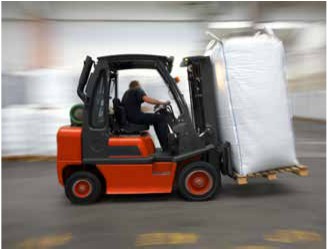
Figure 10
Restricted visibility during forward travel
 | Measures |
|---|
In order to prevent or reduce accidents from occurring during the transport of workpieces and material by forklift truck, take the following measures/observe the following provisions:
Observe the widths of traffic routes in accordance with ASR A1.8 (refer also to the information box concerning the width of traffic routes in 3.1.5).
Ensure that training has been provided and proof of competence is available (e.g. training in accordance with DGUV Grundsatz 308-001).
The forklift truck driver must be assigned in writing to the work.
The forklift truck driver must be at least 18 years of age (except during training).
Forklift truck drivers must be suitable for the task concerned. For further details, refer to Chapter 3.1.5, Competence, qualification, preventive medical care, aptitude.
Briefing on use of the forklift truck
The capacity stated on the forklift truck’s load capacity plate must be observed.
Use of the restraint system (such as full cab, safety bar systems, lap belt).
Instruction on correct dismounting (three-point contact).
The forklift truck must be inspected regularly by a competent person.
The operator must carry out a daily visual and functional inspection of the forklift truck before using it.
The forklift truck must be used only for its intended purpose in accordance with the manufacturer’s instruction handbook.
The following additional measures have proved effective in practice:
Use of safety bar systems or a cab door rather than lap belts
Visual driving path warning system
Safely reduced speed in areas with increased mixed traffic (foot traffic and forklift trucks)
Wearing of easily visible clothing (such as a high-visibility vest) in areas with increased mixed traffic (foot traffic and forklift trucks)
Use of diesel-engined forklift trucks in shops:
Soot particles are considered a cause of lung cancer. For this reason, the use of diesel-engined industrial trucks in completely or partially enclosed rooms or shops is considerably restricted under the German Ordinance on hazardous substances (GefStoffV) and the TRGS 554 Technical rules concerning hazardous substances (diesel engine emissions) when the same task can be performed by emission-free drive technologies capable of providing the required engine power or load capacity.
One restriction is that diesel-powered industrial trucks used inside buildings must be equipped with a soot filter. Outdoor use is not subject to restrictions.
Use on public roads
Where forklift trucks are used occasionally on public roads, the following additional measures are required:
Driving licence in accordance with the German Road traffic act (StVG)
Type approval certificate of the forklift truck in accordance with the German Vehicle registration ordinance (StVZO)
Marking with the address of the keeper or an official registration plate, depending on the vehicle type
Ancillary equipment of the forklift truck in accordance with the information sheet for forklift trucks issued by the German Federal Ministry of Transport
3.1.9 Cranes
Transporting loads can be difficult and arduous. Cranes facilitate this work, since they multiply the human force and are thus able to lift loads without difficulty, and also move them in one or more directions. Cranes are used in heat treatment plants for routine handling of workpieces and material, and also for maintenance and for charging furnaces and quenching baths.
 | Statutory references |
|---|---|
| |
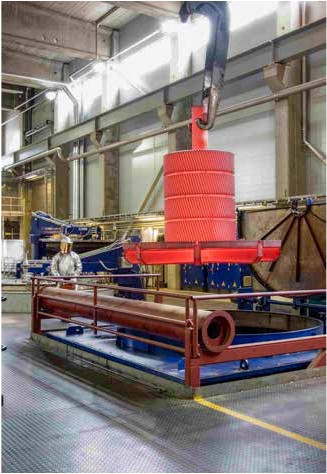
Figure 11
Red-hot charge on the crane (before quenching)
 | Further information |
|---|---|
| |
 | Hazards |
|---|
A wide variety of crane types exist, including trolley cranes, jib cranes, slewing cranes, bridge cranes, gantry cranes, walking cranes, tower cranes, mobile cranes, floating cranes and cable cranes.
Where cranes are used to transport loads, a range of hazards to the life and health of persons, to property and to the environment may arise. These include:
Load drop caused by component failure
Collision with or crushing of persons by the load caused by travel movements
Tipping over, load disengagement and drop
Vibration caused by uneven craneways and by transport processes such as lifting and depositing of loads
Such hazards exist not only for those working directly with the crane, such as crane operators and slingers, but also for persons employed or present in the operating range of cranes.
 | Measures |
|---|
Measures relating to the crane:
Observance of the load-bearing capacity, hoisting height, outreach, etc. during selection of the crane
Regular and timely inspections of cranes, lifting gear, load handling attachments and slings; for provisions governing inspection requirements, refer to DGUV Regulations 52 and 53, the German Ordinance on industrial safety and health (BetrSichV) and the instruction handbook. For checklists for crane inspection, see DGUV Grundsatz 309-001; for discard criteria for ropes, see ISO 4309; for discard criteria for hooks, see DIN 15400 - DIN 15406
Compliance with the maintenance intervals in accordance with the instruction handbook
Immediate performance or instigation of corrective maintenance and elimination of defects
Daily operational safety check of the crane including craneway (start of work, shift change, end of work)
Measures to be taken when cranes are used on open oil baths:
Use of the crane as intended
Prevention of unauthorized access to/use of cranes
Tasking of suitable, trained (instructed) persons with operation of the crane
Instruction of the employees
Presence of persons on or beneath suspended/swinging loads is prohibited.
Measures for transport routes:
Transport routes must be kept clear.
A clear view must be maintained (particularly near doors, gates, passages, crossings).
Design of transport routes: as far as possible without overlap, separated from foot traffic, or with dedicated lanes for each direction.
Marking of transport routes.
Sufficient lighting.
Measures to be taken when cranes are used on open oil baths:
The descent rate of the crane must be at least 20 cm/s.
Should the drive power fail, it must still be possible to lower the load fully into the quenching bath (e.g. by emergency lowering device, emergency power supply).
Operation of the crane without risk must still be possible when the surface of the bath is on fire (e.g. by means of a remote control, heat shield).
The crane must be protected against flames, for example by nitrogen flooding of the bath surface.
Slings must be suitable for the thermal load.
Equipment for positioning the crane quickly and accurately over the quenching bath has proved effective.
3.1.10 Servicing and maintenance
Approximately one-fifth of fatal occupational accidents occur during maintenance work. The reasons are manifold. The most common accident scenario is the falling of persons from plants or ladders, and entrapment, crushing or collisions by/with parts of plants. The causes are primarily to be found in incorrect organization or behaviour.
 | Statutory references |
|---|---|
| |
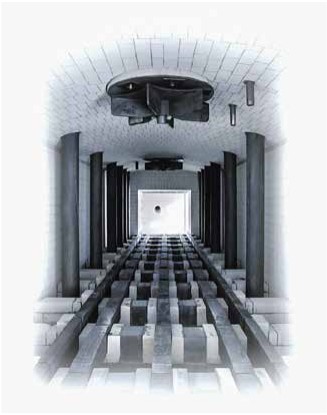
Figure 12
Furnace chamber in a pusher type furnace
 | Hazards |
|---|
Numerous different hazards occur during maintenance and servicing work. The most significant hazards are:
Falls from plant and ladders
Crushing, entrapment or collision by/with moving parts
Crushing, entrapment or collision caused by unexpected start-up
Electric shock
Poisoning (in some cases with several years’ latency), chemical burns, burns caused by escaping media
Inadvertent disabling (possibly partial) of the plant’s safety concept during maintenance, repairs or conversion work owing to insufficient knowledge of the safeguards
 | Measures |
|---|
Should work equipment and plant no longer be in a safe condition, you are obliged as the employer to instigate repair measures immediately. The use of unsafe work equipment and plant is not permitted.
You must also base maintenance measures on the results of a risk assessment and observe the information provided by the manufacturer in the instruction handbook.
Maintenance, repairs and conversions may be performed only by persons in possession of the necessary expertise and capable of assessing the effect of their activities on the safe condition of the plant. This also applies to the selection of service providers. Where you task your own personnel with the work, you must ensure that they are suitably qualified.
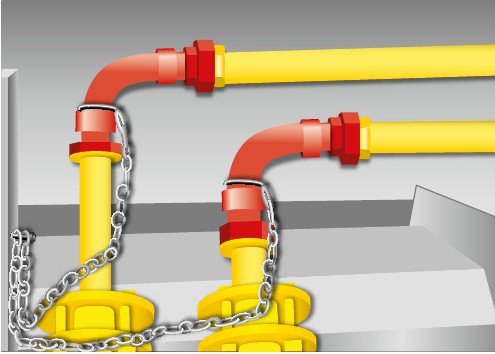
Figure 13
Removable spool pieces for isolation of the gas supply
The following elements are important for the safe performance of maintenance measures:
It must be set out clearly who is responsible for which safety measure.
Clear communication between operating and maintenance personnel is required, for example by means of a defined handover procedure.
Should operation and maintenance be performed simultaneously or several companies work on the plant at the same time, these activities must be coordinated. Where the activities give rise to a mutual hazard, managerial authority must be granted to the coordinating personnel.
The work area must be safeguarded during the performance of maintenance work; if necessary, access by unauthorized persons must be prevented.
Safe access must be provided to the maintenance points, particularly during working on installations.
Raised components/work equipment must be secured or lowered.
Hazardous stored energy (such as compressed air, spring force) must be released or safeguarded and marked.
Hazardous media must be removed and safely isolated (e.g. removable spool pieces on gas lines). Even when escaping gases are non-toxic and nonflammable, such as nitrogen, they may displace oxygen very quickly in small rooms, leading to danger of suffocation.
Hazardous forms of energy (such as electricity) must be safely isolated.
Safe working procedures must be laid down.
Where the maintenance operations give rise to particular hazards, corresponding warnings and information must be posted.
Access clearance arrangements must be put in place for certain work (accessing of vessels, confined spaces, furnace chambers).
During servicing work, stoppages (scheduled or unscheduled) or certain forms of inspection work (pits, on the furnace plant, etc.), the carrying of mobile gas warning devices is recommended. Ensure that the gas warning devices are inspected visually by an instructed person before each working shift.
A function check must be carried out by qualified personnel and documented every 6 months, a system check by a competent person once a year.
Before work is begun in places to which access is difficult, the rescue arrangements must be clarified. Where special rescue equipment is required, it must be readily accessible in the vicinity of the work.
Instruction must be provided on the function of extinguishing systems and extinguishing agents and the hazards presented by them.
Where technical safeguards must be disabled to permit maintenance work or hazardous energy cannot be isolated, you must take other measures to ensure the safety of your employees. It is however imperative that the technical safeguards be put back into operation after the maintenance work. Proper functioning of the technical safeguards must be checked. One problem is that technical safeguards that have been disabled are often not needed for normal operation; should they fail to function properly, this therefore goes unnoticed.
 | Handover of the furnace plant |
|---|---|
Proven good practice is for the instantaneous condition of the plant to be documented
in a handover protocol at handover by the operating to the maintenance personnel.
Issues such as the following are thus clear and comprehensible even should the persons
involved no longer be on the site:
| |

Figure 14
Work in a furnace plant
 | Accessing a furnace plant |
|---|---|
A clearance system (access permit) must be employed for authorization of access to
a furnace plant. The clearance system sets out what measures are to be carried out
before a furnace plant is accessed. The specific measures to be taken depend upon
several aspects, such as the design of the plant, the process and the tasks to be
performed, and must be determined in advance as part of a risk assessment. Measures
typically taken are:
| |
 | Handling man-made mineral fibres |
|---|---|
| Man-made mineral fibres may be released in the course of servicing and maintenance work on furnace plants. The material from which wool used in the furnace is made must therefore be determined before the work is started. Aluminium silicate (ASW), polycrystalline (PCW) and alkaline earth silicate (AES) wools are now commonly used in furnace construction. The TRGS 558 Technical rules concerning tasks involving high-temperature wool set out measures that must be applied for activities involving aluminium silicate wool. Where PCW wools are installed, application of the measures is recommended. Where AES wools are installed, the general safety measures of the German Hazardous substances ordinance (GefStoffV) must be applied. Measures in accordance with TRGS 558 include: At fibre concentrations of up to 10,000 fibres per m3(exposure category 1) (operating and monitoring tasks on industrial furnaces):
| |
3.1.11 Inspection on heat treatment plants
Safe plants are an important element in occupational safety. Responsibility for the safety of plants lies in the first instance with their manufacturers. Your task as the plant operator is to keep the plant in a safe condition over its entire mission time.
 | Statutory references |
|---|---|
| |
 | Hazards |
|---|
Safeguards often go unnoticed during normal and trouble-free operation. A defect in a safeguard is therefore not normally apparent. At the same time, safeguards are relied upon to function and prevent any danger to operating personnel when a demand is made upon them.
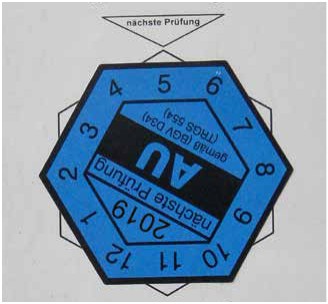
Figure 15
Inspection sticker showing the date of the next inspection
 | Measures |
|---|
Whether safeguards are intact can be determined only by inspections. Inspections differ in their interval, the scope of the inspection and the competence of the inspector.
An inspection may be prompted by:
Expiry of the inspection interval
An incident, such as malfunction, damage or repair
Simpler inspections can often be carried out by the personnel operating the plant. These inspections are minor in their scope (e.g. visual inspection), have short intervals (once each shift, daily, weekly) and entail little effort (reading off of parameters such as pressure, flow rate, etc.).
More detailed inspections are often carried out as part of annual servicing or during repairs. In this case, disassembly, comparative measurements, functional checks, etc. are carried out in order for information to be obtained with which the instantaneous condition of the safeguard can be assessed and a prognosis made of its serviceability through to the next inspection. The performance of such inspections requires sound technical knowledge and the regular performance of inspection tasks by which, for example, the level of wear and wear reserves can be assessed. The German Ordinance on industrial safety and health (BetrSichV) describes a person competent to carry out an inspection in this context. Should your employees not possess sufficient knowledge, it is more appropriate to have these inspections performed by external service providers.
You must determine what inspections are to be carried out on your plant and work equipment and at what intervals as part of the risk assessment performed in accordance with the BetrSichV. The manufacturer’s instruction handbook serves as a good source of orientation.
Instruction handbooks for older furnace plants may not contain information on inspections, or may not even be available. The inspections required for plant safety are
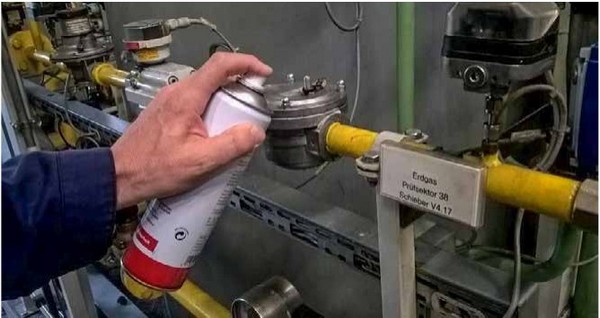
Figure 16
Leak detection by means of a leak detection spray
determined by the plant’s safety concept. Inspections must be performed both of any individual component required for functioning of the safety concept, and of the safety system as a whole. The support of third parties (e.g. furnace plant manufacturers) may be advantageous for determining the scope of inspection.
The inspection must be documented and the documentation retained at least until the next inspection is performed. The documentation must include the date, type, scope and result of the inspection. The inspections may also be documented in electronic form.
The following points should also be documented:
The codes in accordance with which inspection was performed
The individual inspection points with the respective results
Evaluation of detected faults and conclusions with respect to continued operation
The identity of the inspector
Correction of the detected faults
For assessment of the condition of the plant as-is and predictions of how this will develop, the results and conclusions of previous inspections are useful, as well as those of the most recent inspection.
Useful advice on performing inspections of furnace plants in practice:
Gather the documents that will ensure a systematic inspection of the plant, such as checklists, tables and manufacturers’ information.
Leaks from systems transporting gas (pipelines and fittings)
Leak tests must be performed at test pressure and at least at the nominal operating pressure. The leak test comprises two tests:
Outward leakage
Outward leakage usually occurs at unions and on fittings (valves, instrumentation). Leaks can be detected with the use of gas meters and leak detection spray. The use of leak detection spray containing sulfur dioxide (SO2) has proved effective for detecting ammonia leaks.
Internal leakage/leakage from shut-off devices The purpose of this test is to determine whether shut-off devices (valves) are leak-tight when closed. The test involves trapping gas under pressure between two closed shut-off devices and observing the drop in pressure.
Pressure gauges
Since pressure gauges tend to drift continuously, they must be adjusted.
Joint declaration by the BMAS and the social partners on mental health in the world of work; BMAS, 2013
